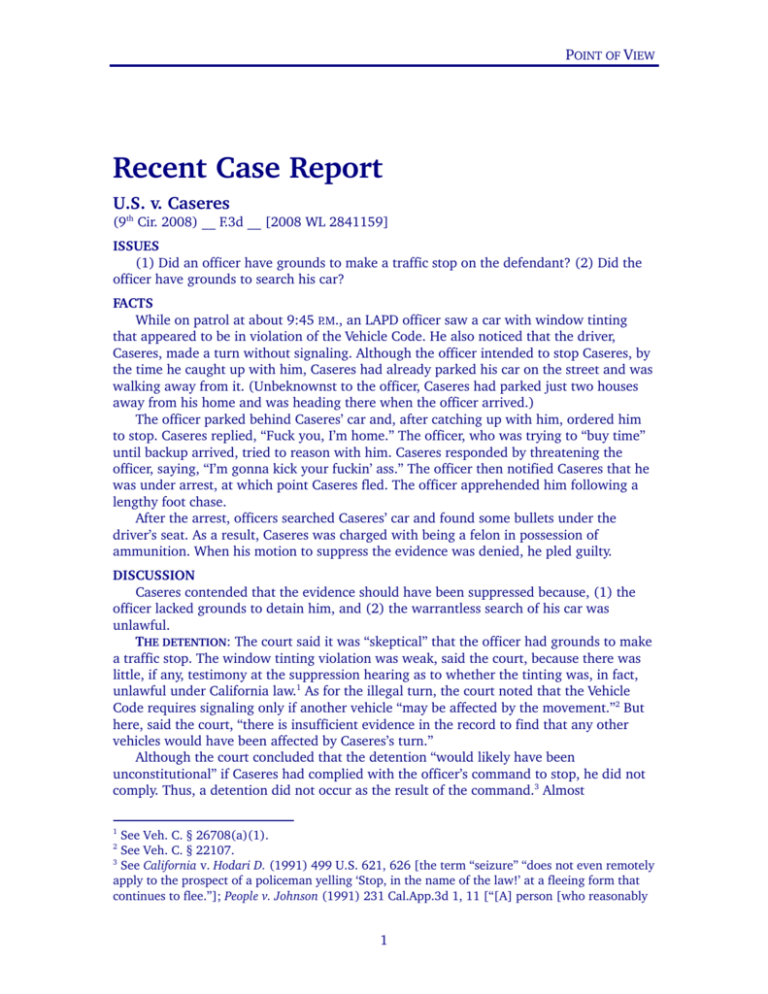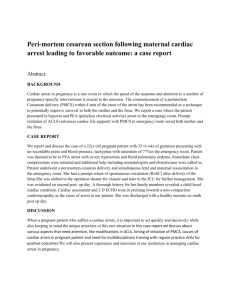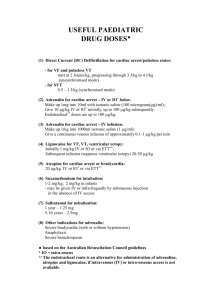U.S. v. Caseres - Alameda County District Attorney's Office
advertisement

POINT OF VIEW Recent Case Report U.S. v. Caseres (9th Cir. 2008) __ F.3d __ [2008 WL 2841159] ISSUES (1) Did an officer have grounds to make a traffic stop on the defendant? (2) Did the officer have grounds to search his car? FACTS While on patrol at about 9:45 P.M., an LAPD officer saw a car with window tinting that appeared to be in violation of the Vehicle Code. He also noticed that the driver, Caseres, made a turn without signaling. Although the officer intended to stop Caseres, by the time he caught up with him, Caseres had already parked his car on the street and was walking away from it. (Unbeknownst to the officer, Caseres had parked just two houses away from his home and was heading there when the officer arrived.) The officer parked behind Caseres’ car and, after catching up with him, ordered him to stop. Caseres replied, “Fuck you, I’m home.” The officer, who was trying to “buy time” until backup arrived, tried to reason with him. Caseres responded by threatening the officer, saying, “I’m gonna kick your fuckin’ ass.” The officer then notified Caseres that he was under arrest, at which point Caseres fled. The officer apprehended him following a lengthy foot chase. After the arrest, officers searched Caseres’ car and found some bullets under the driver’s seat. As a result, Caseres was charged with being a felon in possession of ammunition. When his motion to suppress the evidence was denied, he pled guilty. DISCUSSION Caseres contended that the evidence should have been suppressed because, (1) the officer lacked grounds to detain him, and (2) the warrantless search of his car was unlawful. THE DETENTION: The court said it was “skeptical” that the officer had grounds to make a traffic stop. The window tinting violation was weak, said the court, because there was little, if any, testimony at the suppression hearing as to whether the tinting was, in fact, unlawful under California law.1 As for the illegal turn, the court noted that the Vehicle Code requires signaling only if another vehicle “may be affected by the movement.”2 But here, said the court, “there is insufficient evidence in the record to find that any other vehicles would have been affected by Caseres’s turn.” Although the court concluded that the detention “would likely have been unconstitutional” if Caseres had complied with the officer’s command to stop, he did not comply. Thus, a detention did not occur as the result of the command.3 Almost 1 See Veh. C. § 26708(a)(1). See Veh. C. § 22107. 3 See California v. Hodari D. (1991) 499 U.S. 621, 626 [the term “seizure” “does not even remotely apply to the prospect of a policeman yelling ‘Stop, in the name of the law!’ at a fleeing form that continues to flee.”]; People v. Johnson (1991) 231 Cal.App.3d 1, 11 [“[A] person [who reasonably 2 1 ALAMEDA COUNTY DISTRICT ATTORNEY’S OFFICE simultaneously, however, the officer developed probable cause to arrest Caseres because of the threat (“I’m gonna kick your fuckin’ ass”).4 Consequently, the court ruled the officer had probable cause to arrest him. THE VEHICLE SEARCH: The government contended that the ammunition was admissible because the search of Caseres’ car qualified as a search incident to the arrest. The court disagreed. It is settled that officers may search a vehicle incident to an arrest if, (1) the arrestee was an “occupant” or “recent occupant” of the vehicle; (2) there was probable cause to arrest him; (3) the arrest was custodial in nature (meaning the suspect would not be cited and released); and (4) the search was “contemporaneous” with the arrest. Here, the officer had probable cause to arrest, and he presumably intended to take him into custody for it. Thus, the second and third requirements were satisfied. It was the other two that presented problems. Caseres argued that he was not an “occupant” of the vehicle because, as noted, he had already parked his car and was walking away when the officer arrived on the scene. Furthermore, the officer did not develop probable cause to arrest him until well after Caseres had exited the car. But even if an arrestee was not inside the vehicle when he was arrested, the courts have ruled that the “occupant” requirement will be met if, (1) officers saw the arrestee exit the car and he was near it when arrested,5 or (2) officers had reason to believe the arrestee was a recent occupant of the vehicle, and that he continued to have a “close association” with it; e.g., an officer saw him standing next to the vehicle and discard a beer can inside it.6 But neither of these circumstances existed because, as the court pointed out, “the attempted detention of Caseres did not occur until after he had parked, exited his car, and was walking through a yard to his residence—which was two houses down the street.” The court also ruled that the search was not “contemporaneous” with the arrest. While the word “contemporaneous” in common usage refers to situations in which two acts occur at about the same time, a search incident to arrest need not occur simultaneously with the arrest or even immediately thereafter. What counts is whether the search was “roughly” or “substantially” contemporaneous with the arrest. For example, even if the time lapse was significant, the search will ordinarily be upheld if there was a good reason for the delay, or if the search and arrest were part of a closely connected progression of events.7 believes] he is not free to leave is nevertheless not detained for Fourth Amendment purposes until he either submits to that show of authority or is physically seized by the officer.”]. 4 See Pen. C. § 69. 5 See New York v. Belton (1981) 453 US 454; Thornton v. United States (2004) 541 U.S. 615, 621 [“In all relevant aspects,” said the Court, “the arrest of a suspect who is next to a vehicle presents identical concerns regarding officer safety and the destruction of evidence as the arrest of one who is inside the vehicle.”]; U.S. v. Osife (9th Cir. 2005) 398 F.3d 1143, 1146 [defendant “had recently occupied the car and was standing near it when he was placed under arrest. [T]he search was therefore permissible under the Fourth Amendment.”]. 6 See People v. Stoffle (1991) 1 Cal.App.4th 1671. 7 See People v. McBride (1969) 268 Cal.App.2d 824, 829 [“Manifestly, the second search was part of a continuous process which began with a valid arrest”]; People v. Webb (1967) 66 Cal.2d 107, 2 POINT OF VIEW In ruling that the search and arrest were not contemporaneous, the court in Caseres said that, after the arrest, the officers engaged in unnecessary intervening actions; i.e., they “took time to question Caseres, to converse with one another, and to transport themselves back and forth between the arrest site and the vehicle’s location.” Thus the court ruled “the search of Caseres’s car was too far removed in time from the arrest to be considered as incidental to Caseres’s arrest.” For these reasons, the court ordered the suppression of the ammunition that was found in Caseres’ car.8 COMMENT In discussing whether Caseres was an “occupant” of the vehicle, the court indicated that the critical distance was the amount of space between Caseres’ car and the point at which the arrest occurred.9 This was incorrect. The relevant distance was that between Caseres’ car and the spot at which he fled from the officer. This is because the courts will not permit an arrestee to avert a vehicle search by fleeing and thereby distancing himself from the car.10 POV 120 [court noted an “emphasis on the ‘continuing series of events’”]; U.S. v. McLaughlin (9th Cir. 1999) 170 F.3d 889, 892; U.S. v. Brown (D.C. Cir. 1982) 671 F.2d 585, 587. 8 NOTE: The government also argued that the search could have been justified as an inventory search. But, as the court pointed out, there was no need to two the car because it was legally parked near Caseres’s home. Furthermore, “[t]he possibility that the vehicle would be stolen, broken into, or vandalized was no greater than if the police had not arrested Caseres as he returned home.” 9 NOTE: The court said, “Given the distance between Caseres and his car at the time of the arrest, we hold that the search of his car was not a valid search incident to arrest”; Caseres was arrested “at a location a full block and a half away from the car.” Emphasis added. 10 See People v. Pressley (1966) 242 Cal.App.2d 555, 560; People v. Williams (1967) 67 Cal.2d 226, 229 [“Of no legal significance is the fact that defendant, through his efforts to escape, succeeded in separating himself from the car by a distance of about one block. A defendant’s absence from the scene does not of itself render illegal a search which, in view of the totality of surrounding circumstances, is reasonable.”]; People v. Superior Court (Reilly) (1975) 53 Cal.App.3d 40, 48. 3








